
If you’ve been reading my reviews for very long, you’re aware that the World War II era holds special fascination for me. This might have something to do with the fact that I was born then—in fact, about six months before the USA entered the war. Or maybe it’s just because it all preceded the disillusionment that set in once the war had ended, when the boundaries between good and evil no longer seemed so clear.
This post was updated on July 3, 2024
In addition to the many World War II novels I’ve read and reviewed here, both mysteries and trade fiction, I’ve read a great many nonfiction books about the years leading up to and during the war. Here I’m listing two dozen of the best I’ve come across in recent years. They cover everything from economic policy in the Depression and the rise of Nazi Germany to the role of business and the conduct of the war itself. All together, they provide a significant dose of insight about what later historians might well conclude was the most significant period in the history of the world.
As is blindingly obvious, this is by no means a comprehensive bibliography. No doubt hundreds of thousands of books have been written about the World War II era. The ten top books and the many runners-up simply represent where my taste and my instincts have taken me in recent years. I’ve arranged these books in alphabetical order by the authors’ last names within each of the two lists below (the top ten and other books about World War II). Each is linked to my review.
10 TOP NONFICTION BOOKS ABOUT WORLD WAR II
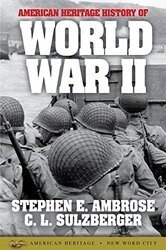
American Heritage History of World War II by Steven E. Ambrose and C. L. Sulzberger (1966, 1997) 640 pages ★★★★★
Thousands of books have been written about World War II—”history’s greatest catastrophe.” Amazon shows more than 70,000 titles. Among them are general histories from the likes of the Smithsonian Institution, the New York Times, and unnumbered others. Although I can’t claim to have read them all, or even more than a handful, the very best short history of World War II that I’ve come across is the product of three eminent authors writing for the American Heritage magazine: Stephen E. Ambrose, C. L. Sulzberger, and David McCullough. You’re unlikely to find a better introduction to the grand sweep, the intensity, and the human reality of the Second World War. Read the review.
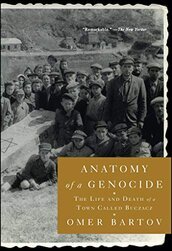
Anatomy of a Genocide: The Life and Death of a Town Called Buczacz by Omer Bartov (2018) 417 pages ★★★★★
Historian Omer Bartov demonstrates how very complicated the Holocaust was. By tracing the history of antisemitism in a single Polish-Ukrainian town from the sixteenth century to the present, and detailing day by day how the Holocaust unfolded there, he brings to light the many nuances lost in historical portraits painted with a broader brush. The book is a masterful effort that should stand for decades if not centuries as one of the most insightful accounts of that shameful episode in what is so casually called civilization. Read the review.
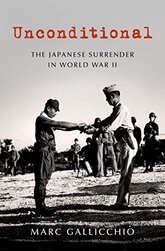
Unconditional: The Japanese Surrender in World War II by Marc Gallicchio (2020) 282 pages ★★★★☆
Three-quarters of a century after the end of World War II, FDR’s policy to demand unconditional surrender from Germany and Japan may seem simply logical. After all, in an era of total war, the only guarantee that either nation wouldn’t sufficiently recover to attack again was total Allied control over their system of government following the end of hostilities. That seemed assured in the case of Germany, which ended the war in rubble and ashes and divided between East and West. But unconditional surrender was a far more complex question with respect to Imperial Japan. For US President Harry Truman to pursue the policy to the end in 1945 involved a complex calculus weighing a host of mutually contradictory military, political, diplomatic, and economic factors. Villanova University historian Marc Gallicchio adroitly untangles them in Unconditional: The Japanese Surrender in World War II. Read the review.

The Secret War: Spies, Ciphers, and Guerrillas, 1939-1945, by Max Hastings (2016) 645 pages ★★★★★
The eminent British historian Max Hastings undercuts the many popular treatments of espionage during World War II with a sober revisionist survey. In his well-informed view, practically nothing either side did in the realm of intelligence had any meaningful impact on the war. The only exceptions, in his view, were the successful efforts by all the major combatants to crack their enemies’ secret codes. Unlike most of other books about the subject, Hastings examines not just the British and American intelligence efforts but those of Russia, Germany, and Japan as well. This is must reading for anyone who wants to understand how espionage really works (or, more often, doesn’t). Read the review.
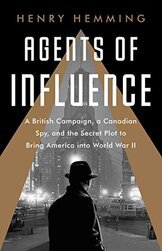
Agents of Influence: A British Campaign, a Canadian Spy, and the Secret Plot to Bring America into World War II by Henry Hemming (2019) 401 pages ★★★★★
In The Splendid and the Vile, a moving and revealing account of Winston Churchill’s leadership during the Blitz, Erik Larson makes much of the Prime Minister’s dogged campaign to persuade Franklin Roosevelt to drag the United States into the defense of Britain. Historians concur that Churchill’s influence on the President played a major role in bringing about American intervention in the European war. But few observers and analysts remark about another factor that may well have been more decisive: British interference in American politics in 1940 and 41 that helped shift public opinion from isolationism to engagement. Because FDR had perfected to a fine art the practice of “leading from behind.” And that’s central to the story so ably told by Henry Hemming in Agents of Influence. Read the review.
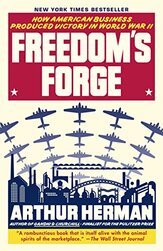
Freedom’s Forge: How American Business Produced Victory in World War II, by Arthur Herman (2012) 433 pages ★★★★★
The US became known as the “arsenal of democracy” because the American business community mobilized on a hitherto unattainable scale to produce hundreds of thousands of airplanes, ships, tanks, trucks, and other war materiel. Arthur Herman’s study of the topic focuses on the efforts of two remarkable industrialists who were among the most prominent figures in the effort: General Motors CEO William Knudsen and shipbuilder Henry J. Kaiser. Read the review.
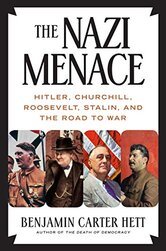
The Nazi Menace: Hitler, Churchill, Roosevelt, Stalin, and the Road to War by Benjamin Carter Hett (2020) 402 pages ★★★★★
The events of the years 1937 through 1941 appear fixed in time. It seems foreordained that Britain, France, the US, and the USSR would have gone to war with Nazi Germany under any circumstances. But that was assuredly not the case, as historian Benjamin Carter Hett makes abundantly clear in his illuminating portrayal of the period, The Nazi Menace. In fact, confusion reigned throughout those years, with the major players stumbling through thickets of uncertainty about one another’s intentions. The forces lined up only haphazardly into the now-familiar split between Allies and Axis. And the alliances in the war that ensued shocked and surprised many of those whose actions had made it inevitable. Read the review.
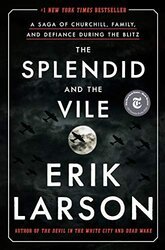
The Splendid and the Vile: A Saga of Churchill, Family, and Defiance During the Blitz by Erik Larson (2020) 546 pages ★★★★★
At the age of sixty-five, Winston Churchill achieved his lifelong dream, becoming Prime Minister of the United Kingdom on May 10, 1940. Less than a year into World War II, Britain was on the brink of defeat. Yet somehow the aging Prime Minister—an alcoholic with a reputation for questionable judgment—mobilized the British people despite what so many were convinced was a hopeless fight against the Nazi juggernaut. Both King George VI and some of Churchill’s colleagues in the Cabinet were skeptical that he was up to the job. Regardless, through sheer force of will and an unparalleled gift for stirring rhetoric, Churchill led his nation virtually alone in the world for eighteen months before the United States finally entered the war. That’s the story Erik Larson tells, and tells so well, in The Splendid and the Vile. Read the review.
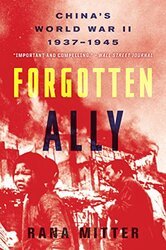
Forgotten Ally: China’s World War II, 1937-1945 by Rana Mitter (2013) 480 pages ★★★★☆
Read just about any popular history of World War II, and you’ll find any number of references to the Allies as the Big Three of Britain, the US, and the Soviet Union. What’s missing is recognition that China bore nearly as high a price as the USSR, with an estimated fourteen to twenty million dead compared to fewer than half a million for the UK and the US. (The Soviet Union lost as many as twenty-four million dead.) On that basis alone, Oxford University historian Rana Mitter is justified in titling his revisionist history of China in World War II Forgotten Ally. But, as he explains at length, recognition of China’s contribution to the war effort is overdue on a far broader basis than that. Read the review.
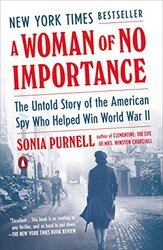
A Woman of No Importance: The Untold Story of the American Spy Who Helped Win World War II by Sonia Purnell 2019) 368 pages ★★★★★
Popular fiction abounds with superheroes. But it’s not often at all that you’ll come across a true-to-life story of a person who comes even close to the sort of over-the-top heroism that so many popular writers favor. However, the story of WWII American woman spy Virginia Hall (1906-82) fits that bill. In A Woman of No Importance, Sonia Purnell relates the woman’s experience in World War II in compelling and often jaw-dropping detail. It’s the best study I’ve ever read about the British Special Operations Executive (SOE), the American Office of Strategic Services (OSS), and the French Resistance. I found it nearly impossible to put the book down. Read the review.
OTHER TOP NONFICTION BOOKS ABOUT WORLD WAR II
The war in Europe
The Day of Battle: The War in Sicily and Italy, 1943-44, by Rick Atkinson
The Guns at Last Light: The War in Western Europe, 1944-1945, by Rick Atkinson
The Pulitzer Prize-winning military historian Rick Atkinson’s trilogy about the Allied conduct of World War II is sometimes referred to as the best reasonably brief historical treatment of the subject. I read the first of the three books, An Army at Dawn: The War in North Africa, 1942-43, before 2010, when I began posting reviews here. I remember it with admiration. All three books are accessible and written with a fine appreciation for the contributions not just of the generals and admirals who led the war effort but of the enlisted men who carried out their orders and bore the brunt of the conflict.
Warlords: An Extraordinary Re-creation of World War II Through the Eyes and Minds of Hitler, Churchill, Roosevelt, and Stalin by Simon Berthon and Joanna Potts
Historians long debated the Great Man Theory of History attributed to the Scottish essayist Thomas Carlyle in 1840. As we have come to understand the contrasting views on either side of the question, some insist that the course of history is set by the ideas and actions of “great men.” Others assert that the currents of their time carry along even these extraordinary leaders, who are merely actors on the stage of history. We hear little of that debate these days, since today we accept that history is shaped both from above and from below. But a close look at World War II might cause us to reexamine that conclusion. Then, four exceptional men—Hitler, Churchill, FDR, and Stalin—played oversized roles in determining the course of history. And that question rises to the surface in Warlords, an intimate examination of the relationships—and the misunderstandings—among the four.
The Ghost Army of World War II: How One Top-Secret Unit Deceived the Enemy with Inflatable Tanks, Sound Effects, and Other Audacious Fakery by Rick Beyer and Elizabeth Sayles
A headline in a New York Times obituary recently caught my eye. “Gilbert Seltzer, Soldier in Secret Unit That Duped Germans, Is Dead at 106,” it read. In scanning the amazing story of Lieutenant Seltzer’s World War II experience, I came across a reference to a book about the top-secret unit in which he had served. That led me to The Ghost Army of World War II by Rick Beyer and Elizabeth Sayles. Their story, which is profusely illustrated, is one of the most astonishing tales of deception to come out of the Second World War. It’s also immensely entertaining.
The Warsaw Uprising, 1 August to 2 October 1944 by George Bruce
No country in the world suffered greater devastation in World War II than Poland, not even the Soviet Union, where as many as twenty-seven million people died. Poland’s six million dead represented an even higher proportion of the pre-war population—about one in five. And Poland’s cities lay in rubble. Yet the devastation was greater still in Warsaw, the site of two of the signal events of the war: the Warsaw Ghetto Uprising in the spring of 1943 and the Warsaw Uprising of 1944 by the Polish underground. Of the two, the events in the Ghetto have received far more attention. And in The Warsaw Uprising, 1 August to 2 October, 1944, George Bruce fills the gap with a moving, blow-by-blow account of that tragic episode in Polish history—the world’s “first example of full-scale urban guerrilla warfare.”
The Bomber Mafia: A Dream, a Temptation, and the Longest Night of the Second World War by Malcolm Gladwell
In The Bomber Mafia, Malcolm Gladwell departs from the precincts of social psychology he knows so well (The Tipping Point, Talking to Strangers, Outliers) and ventures into the history of World War II. The book, subtitled “A Dream, a Temptation, and the Longest Night of the Second World War,” dramatizes the debate at the heart of the growing use of airpower in the war—the dispute between the two schools of thought about strategic bombing in WWII: high-altitude precision targeting and unrestrained area bombing of cities. Gladwell terms it “a case study in dreams gone awry.” In his telling, the debate was personified by the divergent careers of two US Army Air Force generals, Haywood Hansell and Curtis LeMay. LeMay emerged the winner at the time, and he comes across as the author’s hero.
Das Reich: The March of the 2nd SS Panzer Division Through France, June 1944 by Max Hastings
The renowned British military historian assesses the effectiveness of the French Resistance at a crucial point in the war: when the Nazis desperately sought to reinforce their defense in Normandy—and the Resistance slowed them down by many days.
The Bridge at Remagen by Ken Hechler
In March 1945, Allied commanders were shocked to discover that a small group of American soldiers had defied orders and engineered a strategic breakthrough that would shorten World War II. This remarkable little book is their story.
Normandy ’44: D-Day and the Epic 77-Day Battle for France by James Holland
History can deceive us. When we read about the major events of the past, they appear inevitable with all the black-and-white certainty of words on a page. And that’s certainly true about D-Day. The Allies had assembled such overwhelming force in June 1944 that it may seem they couldn’t possibly have failed to crash past the Nazi defenders in northern France and drive through to Germany. But of course that wasn’t the case at all. This is merely one of the many myths about D Day.
12 Seconds of Silence: How a Team of Inventors, Tinkerers, and Spies Took Down a Nazi Superweapon by Jamie Holmes
You can’t help knowing that the atomic bomb was a product of World War II and greatly influenced its outcome. If you’ve read a little, you’re aware that radar played a decisive role in the war as well, implemented both in the air, at sea, and on land. But it’s less likely you’ve heard about a third technological breakthrough that many military analysts and historians believe was equally important. It’s called the proximity fuse. “Known as the world’s first ‘smart’ weapon, the proximity fuse (or fuze) was a five-pound marvel of engineering, industry, and can-do spirit.” And its development and deployment is the subject of Jamie Holmes‘ impressive if idiosyncratic book, 12 Seconds of Silence.
Brothers, Rivals, Victors: Eisenhower, Bradley, Patton and the Partnership That Drove the Allied Conquest in Europe by Jonathan W. Jordan
This is the story of three American generals, their on-again, off-again friendship, and the military operations they led from 1942 to 1945 to win the war against Nazi Germany. For those old enough to remember the history, two of their names live on in memory, the third, much less often. But all three played pivotal roles in World War II, and military historians credit them with a large share of responsibility for the Allies’ success in Europe. But when the United States entered the war in December 1941, few at the time would have expected such exalted achievements from any of the three. Dwight D. (Ike) Eisenhower, Omar N. (Brad) Bradley, and George S. Patton rose through the ranks of American officers at a meteoric pace. Historian Jonathan W. Jordan tells their astonishing story in Brothers, Rivals, Victors, and he tells it exceedingly well.
The war in the Pacific
The Admirals: Nimitz, Halsey, Leahy, and King—The Five-Star Admirals Who Won the War at Sea by Walter R. Borneman
They were children of the Victorian Era. Annapolis graduates around the turn of the twentieth century. Junior officers in World War I, captains by 1927. They gained their first admiral’s stars by the 1930s, and all four were near or past retirement age when war broke out. Yet they rose to the pinnacle of leadership in that war and played outsized roles in the Allied victory. And one by one, as their talents became unmistakably clear, they each received a fifth star, becoming the only five-star admirals in American history. Walter Borneman engagingly tells their stories in his joint biography, The Admirals.
The Fall of Japan: The Final Weeks of World War II in the Pacific by William Craig
Twenty-two years after the war ended, American historian William Craig revealed how Japan’s unconditional surrender came about. He dug into hidden documents and spoke with dozens of those who played pivotal roles at the time both in Japan and the US. Day-by-day, and often hour by hour, Craig reconstructed the events that unfolded in Tokyo as the Empire of Japan pondered the Allies’ inflexible demands. He focused on the fateful days between August 9, 1945, when Fat Man detonated over Nagasaki, and August 15, when Emperor Hirohito radioed a message to Switzerland accepting the Allied terms of surrender. The story Craig tells in The Fall of Japan is at once compelling, disturbing, and illuminating. This book is a stellar example of how history can shine a bright light underneath the surface myths and reveal the messy human reality of the past.
Whirlwind: War in the Pacific by Richard Freeman
Within just six months of the devastating attack on Pearl Harbor, the United States Navy reversed the strategic trajectory of the war in the Pacific. By mid-June, the Japanese Imperial Navy was on the defensive. In the Battle of the Coral Sea (May 4-8, 1942), the American fleet met the best the Empire could bring to the war and fought them to a standstill. And at Midway (June 4-7, 1942), US forces under Admirals Jack Fletcher and Raymond Spruance cut the heart out of the Japanese Navy, destroying four of the empire’s six heavy aircraft carriers. Afterwards, despite Japanese gains on the Asian continent, the die was cast for the United States to prevail. And it’s those three battles—Pearl Harbor, the Coral Sea, and Midway—that Richard Freeman analyzes in Whirlwind.
Shanghai 1937: Stalingrad on the Yangtze by Peter Harmsen
To an outsider, a rapid Japanese victory in the 1937 Battle of Shanghai might have appeared inevitable. That Emperor Hirohito and the militarists who commanded the Japanese Imperial government shared that opinion. After all, the country had been building its military into a world-class force for nearly seventy years since the Meiji Restoration of 1868. The Chinese were no match for the mechanized might of the Japanese Army on land and its superiority both in the air and on the water. Unsurprisingly, then, as Harmsen notes, “[i]n their habitual disdain for the Chinese, the Japanese leaders figured that this would be more than enough to deal with the nuisance across the sea.” They expected to take Shanghai within days. “Underestimating the foe was a mistake they were to repeat again and again in the coming weeks and months.”
Storm Clouds Over the Pacific, 1931-1941 (War in the Far East #1 of 3) by Peter Harmsen
Anyone with more than a cursory knowledge of World War II knows that the Soviet Union paid the greatest price for resisting the Nazis. Estimates of the country’s total dead range from 24 to 30 million. But fewer know that China’s losses in the war were also massive. They were somewhere between 15 and 20 million, far greater than those in any other country. But for the USSR the war lasted four years. For China, it lasted fourteen. Because beginning in 1931, the Empire of Japan seized China’s northernmost province, Manchuria, and held it until the war’s bitter end—while occupying nearly half the rest of the country. And, in Storm Clouds Over the Pacific, 1931-1941, the first in a series of three short books, author Peter Harmsen offers an account of the first decade of World War II in China in grim and sometimes painful detail.
Rescue at Los Baños: The Most Daring Prison Camp Raid of World War II by Bruce Henderson
Early in 1945, as the Nazi regime began to crumble and American soldiers, marines, and sailors relentlessly pushed ever closer toward the Japanese home islands, two thousand civilian prisoners of war, mostly Americans, suffered indescribable deprivation at the hands of a sadistic prison camp commander, deep in a Philippine jungle. Their story—and that of their liberators—is brilliantly told in Bruce Henderson‘s Rescue at Los Baños. It’s a tale of courage and resourcefulness that illuminates one of the most revealing chapters in the history of World War II.
Dead Reckoning: The Story of How Johnny Mitchell and His Fighter Pilots Took on Admiral Yamamoto and Avenged Pearl Harbor by Dick Lehr
This is the story of two men, one Japanese, the other American. They’re 30 years apart in age and might have come from different galaxies for all the different ways their experience has shaped them. One is Admiral Isoroku Yamamoto, commander in chief of the Japanese Empire’s Combined Fleet. He’s the man who planned the surprise attack on Pearl Harbor carried out on December 7, 1941. The other is Major John Mitchell of Enid, Mississippi. Known as Mitch, he commanded the US Army Air Forces fighter squadron that ended the admiral’s life on Palm Sunday, April 18, 1943, exerting revenge for Pearl Harbor. (The mission was called Operation Vengeance.) In Dead Reckoning, journalist Dick Lehr brings both men back to life in a compelling account of their lives up to the fatal moment when their timelines intersected.
The Duel: The Eighty-Day Struggle Between Churchill and Hitler by John Lukacs
On May 10, 1940, two historic events grabbed the world’s attention. Hitler’s Panzer armies broke through the French frontier. And King George VI asked Winston Churchill to form a new government. To tell the story of the eighty days that followed, historian John Lukacs frames the conflict between Britain and Nazi Germany as a “duel” between Churchill and Adolf Hitler. The book is a worthy account of the early days of World War II in Europe.
Prisoners of the Castle: An Epic Story of Survival and Escape from Colditz, the Nazis’ Fortress Prison by Ben MacIntyre
World War II prisoner-of-war escapes are a staple of adventure fiction. IMDB lists twenty-one films on the theme, most prominently the 1963 production The Great Escape, starring Steve McQueen, James Garner, and Richard Attenborough. In reality, however, successful escapes were rare. Britain’s Imperial War Museum notes that “Of the 170,000 British and Commonwealth prisoners of war in Germany in the Second World War, fewer than 1,200 of them managed to escape successfully and make a ‘home run.'” But the numbers fall far short of conveying the sheer drama in the German camps. And perhaps the most colorful examples have emerged from Colditz, the Nazi camp for Allied officers in Germany’s east from 1939 to 1945. Author Ben MacIntyre brings the drama into high relief in Prisoners of the Castle, a nonfiction rendering of life in the most famous of the nearly one hundred WWII Nazi POW camps.
Day of Deceit: The Truth About FDR and Pearl Harbor by Robert B. Stinnett
When you challenge the historical consensus fundamental to our understanding of the past, you’d better be prepared for trouble. And that’s exactly what Robert Stinnett got when he published Day of Deceit, purporting to tell the truth about Pearl Harbor. Picking up on a charge long ago rejected by most historians, he claimed that President Franklin D. Roosevelt knew the Japanese were about to attack Pearl Harbor and deliberately withheld the information from the admiral in charge there. When Stinnett’s book was published in 1999, the New York Times review was typical: “Despite a dogged and sometimes compelling effort . . . Stinnett has produced no ‘smoking guns'” to substantiate his arguments. Established historians piled on, questioning the reliability of some of his sources and rejecting the evidence he produced to support his conclusions.
Although he fails to convict FDR of the charge he levels at him, he does succeed in revealing an even more explosive finding about US involvement in starting the war in the Pacific. And he successfully proves that historians have got it wrong about some aspects of their accounts of the battle that launched the USA into World War I. Unfortunately, his book is very poorly written.
Last Boat Out of Shanghai: The Epic Story of the Chinese Who Fled Mao’s Revolution by Helen Zia
Zia uses the tools of biography to paint a wide-screen view of China’s troubled history from 1937, when Japan launched World War II by invading the country, to 1949, when Mao proclaimed the People’s Republic of China. Her principal subjects are two women and two men among the estimated one million Chinese who fled Shanghai as the Red Army neared the city. One of the women was her mother.
Espionage
Hitler’s Spy Chief: The Wilhelm Canaris Story by Richard Bassett
Most histories of World War II give the impression that the conflict was a straightforward affair. Whether recounting the story of battles (Stalingrad, Normandy, Midway) or the tales of spies and saboteurs (Britain’s SOE, America’s OSS, Germany’s Abwehr), they tend to draw straight lines from one event to the next. Of course, human affairs are never so simple. History doesn’t travel in straight lines. But only in recent years, as classified or hidden files have opened up, have we gained a clearer picture of just how complex and confusing the war was. Hitler’s Spy Chief, Richard Bassett’s biography of Admiral Wilhelm Canaris, director of the Abwehr, makes that abundantly clear. This book reveals that, even today, there is a secret history of World War II that remains to be told.
Night of the Assassins: The Untold Story of Hitler’s Plot to Kill FDR, Churchill, and Stalin by Howard Blum
Novelists including Ken Follett, Jack Higgins, Alan Furst, and Philip Kerr have indulged us with thrilling accounts of spies and saboteurs in World War II. Rarely, though, have they managed to equal in their fiction the sheer audacity of the real-world Nazi plot to kill FDR, Churchill, and Stalin which unfolded in Tehran late in November 1943. This is a story that no novelist could possibly invent and expect to be believed. And Howard Blum tells it with all the skills of a thriller writer in his deeply-researched book, Night of the Assassins.
The Irregulars: Roald Dahl and the British Spy Ring in Wartime Washington by Jennet Conant
Soon after Winston Churchill became Prime Minister of Great Britain in May 1940, he turned to a Canadian industrialist named William Stephenson for help. Stephenson’s charge was to weigh in on his biggest challenge in prosecuting the war against Germany: persuading the United States to join the fight. Churchill appointed Stephenson head of a new top-secret organization dedicated to that purpose. Called British Security Coordination, the new offshoot of SIS (the Secret Intelligence Service, or MI6) was charged with rooting out German spies in America and countering the influence of the hugely popular America First Committee.
The Catcher Was a Spy: The Mysterious Life of Moe Berg by Nicholas Dawidoff
Moe Berg (1902-72) was one of the most confounding men who ever donned a glove in Major League Baseball. He graduated magna cum laude from Princeton, earned a law degree from Columbia, and studied linguistics at the Sorbonne. Berg had a fair command of six foreign languages and could understand many more. He pored through up to ten daily newspapers and wore one of eight identical black suits every day. And during World War II, after a nineteen-year career as a catcher for a succession of American League teams, he enlisted in the OSS and pulled off one of the agency’s most spectacular espionage coups. But nearly all this information has come out elsewhere. If that’s all there were to the story, a biography of Moe Berg wouldn’t be worth reading. But there was much more to the man.
The Woman Who Smashed Codes: A True Story of Love, Spies, and the Unlikely Heroine Who Outwitted America’s Enemies by Jason Fagone
Working with recently declassified files from the World War II era as well as long-ignored archival records and contemporary press reports and interviews, journalist Jason Fagone has brought to light at last the astonishing story of Elizebeth Smith Friedman and her husband, William Friedman. The Friedmans may well have been the most important 20th-century American codebreakers, and quite possibly the best and most successful in the world.
Nancy Wake: The gripping true story of the woman who became the Gestapo’s most wanted spy by Peter FitzSimmons
Recent years have seen a flood of new books belatedly highlighting the role of women in espionage in World War II. Despite rampant sexism and misogyny, women did indeed fill vital roles as spies and analysts in intelligence-gathering as well as partisan activities behind enemy lines. And few women played as prominent a part as a phenomenal Australian woman named Nancy Wake (1912-2011). Her exploits in France during the war have been the subject of at least five books as well as a feature film and a TV series. The best of the books, I’ve found, is Peter FitzSimmons‘ Nancy Wake, which appeared in 2011, the year of her death at the age of 98.
The Bastard Brigade: The True Story of the Renegade Scientists and Spies Who Sabotaged the Nazi Atomic Bomb by Sam Kean
Given the universal perception that German physicists were the best in the world, the Allies feared a nuclear attack almost throughout the war—as late as the middle of 1944. Unaccountably, then, the Allies launched the Alsos Mission to investigate how far the Nazis had progressed in the field only in September 1943. “People called it the Bastard Unit” because it worked independently, hence the title of Sam Kean’s often jaw-dropping account of the perilous effort to explore and undermine the German nuclear program.
Bletchley Park and D-Day: The Untold Story of How the Battle for Normandy Was Won by David Kenyon
Romanticized accounts of the World War II codebreakers at Bletchley Park convey the impression of a cozy community of brainy people with Oxford and Cambridge degrees laboring in isolation in the countryside. And there is some truth in this picture during the first two years of the war. But that changed. By mid-1944, as the Normandy Invasion approached, 7,500 men and women—some three-quarters of them women, as it happened—worked there. They slogged away, day after day, in a cold, sprawling campus fifty miles from London. The place is studded with makeshift huts and drab concrete and steel buildings on 58 acres. By 1945, the head count there grew to almost 9,000 working in three shifts around the clock. The crowding and primitive working conditions resembled a factory more than a military installation, much less an academic campus. Kenyon views it as the Bletchley Park intelligence factory.
Avenue of Spies: A True Story of Terror, Espionage, and One American Family’s Heroic Resistance in Nazi-Occupied Europe by Alex Kershaw
Despite all the reading I’ve done about World War II — dozens, and perhaps more than a hundred books — I found Alex Kershaw‘s book about Occupied Europe and one extraordinary American family’s experience there to be at least as revealing as the best political or military histories. I learned things that would never turn up in conventional history books, things that gave me the feeling that I was getting at least an inkling of what it was really like to live in Nazi-occupied territory while despising the Nazis and everything they stood for.
The Dirty Tricks Department: Stanley Lovell, the OSS, and the Masterminds of World War II Secret Warfare by John Lisle
Historians debate whether Britain’s Special Operations Executive (SOE) and the American Office of Strategic Services (OSS) had a material effect on the outcome of World War II. After all, they operated on the margins, behind enemy lines, never capable of mounting strategically significant missions. But later testimony from military leaders in the war effort insisted they’d made a difference. And whatever their strategic impact might have been, their activities—especially the often colorful antics of the OSS—make for great reading. Which you’re likely to conclude from the latest addition to the abundant literature about Wild Bill Donovan and his charges in the OSS, The Dirty Tricks Department. In the book, historian John Lisle peers into the record of the secret warfare waged by the OSS, revealing some of the agency’s most flamboyant activities.
Code Name: Lise: The True Story of the Woman Who Became World War II’s Most Highly Decorated Spy, by Larry Loftis
She was the most decorated spy in World War II of either gender. Her name was Odette Sansom (later Odette Hallowes). From 1942 to 1945, she served as an officer of Britain’s Special Operations Executive. From November 1942 to April 1943, she worked in southern France as a courier for an SOE network that delivered arms, money, and supplies to the French Resistance. Betrayed by the witless leader of a French network operating in the same area, she was arrested along with her leader and lover, Captain Peter Churchill. She spent the rest of the war in prison, first in France and later at the notorious Ravensbrück concentration camp for women. And when it was all over, she emerged as the war’s most highly decorated spy. Yet these bare-bones facts convey not a hint of the woman’s almost superhuman courage, the subject of Larry Loftis‘s excellent portrait, Code Name: Lise.
The Princess Spy: The True Story of World War II Spy Aline Griffith, Countess of Romanones by Larry Loftis
Most accounts of Allied spies in World War II highlight their heroic exploits. Stealing top-secret documents. Operating clandestine radios. Leading scores or hundreds of Resistance fighters in battle. Or blowing up Nazi troop trains. Aline Griffith did none of these things. But the fascinating story Larry Loftis tells in The Princess Spy reminds us that espionage then involved a great deal more than fighting on the front lines. His tale of a middle-class American woman who became an OSS spy and married into Spanish nobility offers its own rewards for readers eager to understand World War II in depth.
Double Cross: The True Story of the D-Day Spies, by Ben MacIntyre
Operation Mincemeat: How a Dead Man and a Bizarre Plan Fooled the Nazis and Assured Allied Victory by Ben MacIntyre
Rogue Heroes: The History of the SAS, Britain’s Secret Special Forces Unit that Sabotaged the Nazis and Changed the Nature of War, by Ben MacIntyre
Agent Sonya: Moscow’s Most Daring Wartime Spy by Ben MacIntyre
Ben MacIntyre is one of the most prolific and popular of the many historians who have specialized in World War II. Double Cross tells the often astonishing tale of the wildly unconventional people who acted as spies for the Allies and helped mislead the Germans about the location of the Normandy invasion. Operation Mincemeat is the equally improbable story of the deception scheme that misled the Nazis about the Allied invasion of Sicily, directing their attention instead to southern France. British intelligence accomplished this by planting misinformation on the dead body of a supposed “courier” who washed up on the coast of Spain. In Rogue Heroes, MacIntyre’s authorized history of the Special Air Service, we learn the amazing story of the British unit that established the pattern for Special Forces in armies around the world. And Agent Sonya relates the improbable story of one of the war’s most successful intelligence agents. All four books bring history to life with intimate and telling detail.
An Impeccable Spy: Richard Sorge, Stalin’s Master Agent by Owen Matthews
Richard Sorge was an active Communist who began spying for the Comintern immediately after World War I and, later, for Soviet military intelligence (today the GRU). Nonetheless, he managed to join the Nazi Party and eventually become a close personal friend and part-time employee of the German ambassador to Tokyo. Through his access to top-secret Nazi communications, he was able to advise his handlers in Moscow of Germany’s intention to invade the Soviet Union. Meanwhile, he was also running agents who were embedded at the very top of the Japanese government and was equally able to monitor Japan’s on-and-off-again plans to invade Siberia.
A Spy at the Heart of the Third Reich: The Extraordinary Story of Fritz Kolbe, America’s Most Important Spy in World War II by Lucas Delattre
One of the reasons the resistance to Nazism within Germany itself was so meager was the refusal of the Allies to support the men and women who opposed Hitler. Still, many brave souls persisted nonetheless, hoping to overturn the Third Reich and reach a peace agreement with the Americans and British. But the Allies demanded unconditional surrender, and there were few in Germany who could countenance the utter destruction of the land they loved. One of those few exceptional individuals was a mid-level official in the German Foreign Ministry named Fritz Kolbe—and he became the top American spy in the war. In A Spy at the Heart of the Third Reich, French journalist Lucas Delattre tells the astonishing story of Kolbe’s three-year work funneling top-secret documents from Berlin to the CIA in Bern, Switzerland.
Code Girls: The Untold Story of the American Women Code Breakers of World War II by Liza Mundy
During World War II more than 10,000 women worked on cryptography for the US Army and Navy in Washington, DC. They were sworn to secrecy about their work, and to this day some of those who survive, now in their 90s, are still reluctant to talk about it. As Mundy reveals in Code Girls, there were in fact not two (the German Enigma and the Japanese Purple) but three breakthroughs in untangling Axis codes that were decisive, and most of those who worked on all three were women.
Madame Fourcade’s Secret War: The Daring Young Woman Who Led France’s Largest Spy Network Against Hitler by Lynne Olson
She led the largest French Resistance network against the Nazis for nearly five years. Three thousand agents answered to her, and they delivered intelligence to the British that helped the Allies win the war. Yet she has been virtually forgotten for decades, her courage and resourcefulness ignored by Charles De Gaulle and the French Communist Party, the dominant political forces in France for decades. Because she wasn’t politically allied with either. And because she was a woman. Now a new biography belatedly restores her to the spotlight. It reads like a thriller. And it reveals the long-hidden truth about the French Resistance.
Need to Know: World War II and the Rise of American Intelligence by Nicholas Reynolds
World War II began for the United States with a catastrophic intelligence failure at Pearl Harbor. Two decades earlier, during the First World War, the US military had begun building capacity in signals and communications intelligence. But little was left in place by 1941. Yet, just four years later, tens of thousands of Americans were working round the clock in Army, Navy, State Department, and FBI intelligence units and the Office of Strategic Services. Author Nicholas Reynolds tells the story of how this all came about in Need to Know, an eye-opening account of the rise of American intelligence.
D-Day Girls: The Spies Who Armed the Resistance, Sabotaged the Nazis, and Helped Win World War II by Sarah Rose
D-Day Girls spotlights the British Special Operations Executive (SOE), the world’s first large fighting force trained and organized to operate behind enemy lines. Author Sarah Rose pays special attention in D-Day Girls to a handful of women in the French Section (F Section) of the SOE. But throughout she puts their experiences in the larger context. “Women made up some two thousand of the approximately thirteen thousand employees of the Special Operations Executive . . . They were translators, radio operators, secretaries, drivers, and honeypots. Only eight were deployed as special agents in Autumn 1942, when SOE’s first class of female trainees was seconded to France.”
Poland Alone: Britain, SOE and the Collapse of the Polish Resistance,1944 by Jonathan Walker
Stories of the French Resistance crowd library shelves. They’re among the most popular books about World War II. But many give a misleading picture of reality. Only about 500,000 French men and women worked for the Resistance during the five years of the war, a little over one percent of the country’s population. And most enlisted only in the final months of the war, as Allied victory came to seem more likely. By contrast with resistance movements in other occupied countries, especially Poland and Yugoslavia, the French effort was paltry. In Poland, the Underground State was complex, highly organized, and numerous from the outset. It featured its own administration, judiciary system, and educational facilities as well as an army organized along traditional military lines. In Poland Alone, historian Jonathan Walker tells the story of the extraordinary Polish Resistance movement from the perspective of the British, its sole ally.
Wild Bill Donovan: The Spymaster Who Created the OSS and Modern American Espionage, by Douglas Waller
Under Donovan’s forceful leadership, the upstart American agency homed itself in on the storied operations of MI6, the British Secret Service, and forced one Allied commanding general after another to shelter his agents in their armies. Against the prevailing wisdom in military circles, and often the determined opposition of his superiors, he mounted extensive operations to organize partisans in North Africa, in France, in the Balkans and Central Europe, and ultimately in Germany itself. In short, William J. Donovan, raised hell in World War II.
Science and technology in the war
Tuxedo Park: A Wall Street Tycoon and the Secret Palace of Science that Changed the Course of World War II by Jennet Conant
He was a privileged young man, a product of Andover, Yale, and Harvard Law and a first cousin and protegé of Henry L. Stimson (who was variously Secretary of State and War under Presidents Herbert Hoover and Franklin Roosevelt). He made an immense fortune on Wall Street in the 1920s. But his first love was science. Even while helping structure the nation’s electric power industry, he established a lavish private laboratory that attracted leading scientists from all over the world. And when World War II approached, he played a leading role in assembling the men and resources that produced radar and the atomic bomb in record time.
Engineers of Victory: The Problem-Solvers Who Turned the Tide in the Second World War, by Paul Kennedy
The noted historian Paul Kennedy brings to light the often-ignored contributions of the scientists and enlisted soldiers who helped turn the tide in the Allies’ favor in World War II. Their inventions and innovations in the conduct of war may have played as large a role in the ultimate victory as those of the generals and admirals whose names are most closely associated with the war effort. Surely, when millions of men and women served in the Allies’ armed services, the efforts of a handful of individuals can’t possibly be viewed as carrying the brunt of the load.
Churchill’s Shadow Raiders: The Race to Develop Radar, WWII’s Invisible Secret Weapon by Damien Lewis
Military historians tend to agree that radar played a singularly important role in the Allied victory in World War II, arguably greater than the decoding of the German Enigma codes (and certainly greater than the atomic bomb, which only ended the war). But British and American sources tend to disagree on where the critical advances in the technology took place. Unsurprisingly, the British highlight the role of British scientists, the Americans that of Americans. However, in fact, it was Nazi scientists whose contributions may have been the most significant. That’s the little-known fact that comes to light in author and filmmaker Damien Lewis‘s fascinating book about the theft of German radar technology, Churchill’s Shadow Raiders.
Hitler’s Gift: The True Story of the Scientists Expelled By the Nazi Regime by Jean Medawar and David Pyke
Scan any list of the physicists, chemists, and other top scientists who created the atomic bomb under the Manhattan Project. What you’ll find there, one after another, are the names of Europeans who’d fled the Nazis in the 1930s. They dominate the list, and their contributions were the key to the weapon’s development. But the work at Los Alamos only hints at the broader contributions refugees made to British and American science. Because “some 2600 scientists and other scholars left Germany within the first year [alone], the vast majority of them Jewish. Twenty-five per cent of all physicists were lost from German universities in an insane squandering of talent.” And, overwhelmingly, they emigrated to universities in the UK and US, where an inordinate number of them later won Nobel Prizes. In Hitler’s Gift, Jean Medawar and David Pyke tell the amazing stories of the scientists who fled the Nazis.
A Game of Birds and Wolves: The Ingenious Young Women Whose Board Game Helped Win World War II by Simon Parkin
Parkin tells the tale of a top-secret unit established deep underground in Liverpool. There, a small staff developed wargames to help develop new antisubmarine tactics, eventually training thousands of British naval officers who commanded escort vessels protecting the convoys of merchant ships who traversed the Atlantic throughout the war. A retired officer turned game designer named Gilbert Roberts masterminded the effort, working with a staff composed largely of young Wrens, some of them barely out of secondary school. The Western Approaches Tactical Unit (WATU), as it was called, arose out of desperation. Winston Churchill personally set WATU in motion, ordering Roberts to “‘Find out what is happening and sink the U-boats.”
Geniuses at War: Bletchley Park, Colossus, and the Dawn of the Digital Age by David A. Price
When I searched Amazon for “Bletchley Park books,” 269 entries turned up. I’ve read and reviewed at least a half-dozen of them. But David A. Price’s Geniuses at War surprised me. Most accounts of the World War II British codebreakers at Bletchley Park single out Alan Turing (1912-54) as the central figure in the enterprise and the genius who built the first digital computer. It’s not true. Turing’s Bombe was an analog device. He speculated that a digital computer might be faster and more efficient. But others acted on Turing’s ideas and actually designed and built the machine. It was called Colossus. And David A. Price has written their story in Geniuses at War: Bletchley Park, Colossus, and the Dawn of the Digital Age.
Hidden Figures: The Story of the African-American Women Who Helped Win the Space Race by Margot Lee Shetterly
Before UNIVAC, before the IBM 650, computers were people. Nearly all of them were women, and many were Black. Employed by the thousand in the US war effort in World War II, they crunched the numbers and ran the equations to calculate the effects of wind on aircraft and the trajectory of artillery shells and torpedoes. But these women were not entry-level data entry staff, their fingers dancing over the keys of adding machines. They were academically qualified mathematicians. A single equation they worked with might take up “the better part of a page.” The solution to a problem in aeronautics could run to as many as ten pages. These were the Black women profiled so ably in Margot Lee Shetterly’s bestselling book, Hidden Figures. It’s the surprising and hitherto untold story of Black women in the space race.
The Holocaust
The School that Escaped the Nazis: The True Story of the Schoolteacher Who Defied Hitler by Deborah Cadbury
Amazon lists 4,000 books about the Holocaust. Half are nonfiction, such as Elie Wiesel’s Night and Man’s Search for Meaning by Viktor E. Frankl. The rest include such bestselling novels as The Book Thief and The Tattooist of Auschwitz. Of course, some of the innumerable memoirs and novels relate the story of the Holocaust through the eyes of children. But I’ve never come across a book that more poignantly tells the tale from their perspective than Deborah Cadbury’s The School That Escaped the Nazis.
Nazi Billionaires: The Dark History of Germany’s Wealthiest Dynasties by David de Jong
You might expect a book with the title Nazi Billionaires to feature the Krupp family, who manufactured steel and armaments for the Third Reich, and the men behind the chemicals giant I G Farben, notorious for producing the Zyklon B gas used to murder millions in the death camps. But both firms had their roots in earlier centuries and were well established at the pinnacle of German industry long before World War II. Instead, author David de Jong turns our attention to the five families who were the greatest of the Nazi war profiteers, building dynastic wealth by collaborating with Hitler’s regime.
The Last Jews in Berlin by Leonard Gross
When we consider the fate of the Jews in Europe during the Nazi years, our thoughts tend to drift toward stereotypical images. The gas chambers at Auschwitz and other death camps. And doomed Anne Frank cooped up in hiding for two years until she was betrayed. Both images are accurate, as they reflect the experience of millions of European Jews. But there were exceptions, and their experiences tell us a great deal about life in Nazi-dominated Europe. Author Leonard Gross does an excellent job conveying the alternate reality they represented in The Last Jews in Berlin. Yes, it’s true. Jews survived the Holocaust in Berlin.
From Kraków to Berkeley: Coming Out of Hiding, by Anna Rabkin
In a beautifully written memoir, longtime former Berkeley City Auditor Anna Rabkin tells the tale of her flight as a child when the Nazis invaded Poland. After hiding with a Christian family, she eventually moved to England and then to the United States, learning new languages and acclimating herself to the strange new customs of her adopted homelands. This is the odyssey of a Holocaust survivor whose experience parallels in some ways what so many refugees today are facing.
The Last Jew of Treblinka by Chil Rajchman
Rajchman was twenty-eight years old when he and his nineteen-year-old sister were captured in October 1942 and shipped to Treblinka. She was murdered almost instantaneously upon arriving there. But he was pressed into service as a “barber,” employed to cut off the hair of women and girls before they were herded into the gas chambers. Later, as a “dentist” — removing teeth to extract the gold and platinum — and as a laborer in the Sonderkommando, he survived because he was strong and useful to the Nazis. And then, in the course of a camp-wide revolt, he was one of about one hundred Jews who escaped.
Survivor Café: The Legacy of Trauma and the Labyrinth of Memory, by Elizabeth Rosner
Survivor Café is a memoir, but it is far more than that. Rosner set out to understand the impact of her parents’ experiences in the war on her own life. She read deeply in the literature about the Holocaust and about the phenomenon of epigenetics, “the study of environmentally induced changes passed down from one generation to the next.” This emerging field is controversial and its research easily overdramatized. However, interpreting the findings narrowly, Rosner found in it an explanation for her own deep feelings about the Holocaust—and those in other second- and third-generation offspring of survivors.
I Escaped from Auschwitz by Rudolf Vrba and Alan Bestic
Hundreds, perhaps thousands of Holocaust memoirs have seen the light of day in the nearly 80 years since World War II ended. But this one may well be the most important from an historical standpoint. It was based on the author’s eyewitness account in 1944 about Auschwitz that first informed Allied leaders of details about the Final Solution . . . and produced sensational stories in the New York Times and the BBC.
In the Name of Humanity: The Secret Deal to End the Holocaust by Max Wallace
The seemingly unstoppable orgy of murder called the Holocaust probably didn’t end when or how you thought it did. What really happened has come to light in mutually inconsistent accounts in some of the books written about World War II’s final months. But, as best I can tell, none of the authors of those books dug as deeply into the question of how the Holocaust ended as has Canadian Holocaust scholar Max Wallace in his 2017 book, In the Name of Humanity. It’s a tour de force of historical scholarship and an eye-opening look at when, why, and how the killing stopped.
Other aspects of World War II
The Nazi Seizure of Power: The Experience of a Single German Town, 1922-1945, Revised Edition by William Sheridan Allen
Today, Northeim is a railroad town of some 29,000 people in northern Germany. But only about 10,000 called it home in 1930, when the Nazi Party began its explosive rise to dominance throughout the country. Historian William Sheridan Allen chose the town for his study at the local level of how Hitler’s minions succeeded in an alarmingly short time. His account, The Nazi Seizure of Power, spans the years 1922 to 1945. But the heart of the book—as reflected in the subtitle of the original, 1965 edition—covered the years 1930 to 1935. It was during that period when the tiny Right-Wing splinter group called the National Socialist German Workers’ Party (Nationalsozialistische Deutsche Arbeiterpartei) gained the support of nearly two-thirds of Northeim’s voters in three short years and then quickly moved to suppress all opposition.
Year Zero: A History of 1945, by Ian Buruma
Bard College professor Ian Buruma brings into high relief the seminal events of 1945, including the surrender of Germany and Japan, the opening of Germany’s concentration camps, the bombing of Hiroshima and Nagasaki, the founding of the United Nations, and the Yalta Conference that laid the foundations for the Cold War. Much of Buruma’s book is social history, with extensive coverage of such topics as “fraternization” between occupation troops and local women, the conditions faced by millions of survivors trapped (sometimes for years) in “displaced person” camps, the bitter and often violent struggles between the partisans who had waged guerrilla war against Germany and the conservatives who had often collaborated with the enemy, and the hunger that swept through the nations hardest hit in the war, especially Japan and Germany.
Last Call at the Hotel Imperial: The Reporters Who Took on a World at War by Deborah Cohen
They were the media superstars of their time. Millions read their dispatches from overseas, listened to them on the radio, and attended their lectures. In today’s atomized media environment, there is no one who compares to the breadth of their influence on public affairs. The closest analogue were the network TV anchors of the 1960s and 70s. Walter Cronkite. Chet Huntley and David Brinkley. Peter Jennings. Celebrities, one and all. And historian Deborah Cohen brings them back to life in Last Call at the Hotel Imperial, her engaging group biography of the most celebrated American foreign correspondents of the 1930s and 40s. Without exception, they viewed war inevitable as the 1930s unfolded. And they helped lay the foundation for American intervention in Europe when at last it came to the USA.
Half American: The Epic Story of African Americans Fighting World War II at Home and Abroad by Matthew F. Delmont
Histories of the US role in World War II frequently mention the famous Tuskegee Airmen, a segregated African-American fighter squadron that distinguished itself in the European Theater. Sometimes they also cite the 92nd Infantry Division (“Buffalo Soldiers”), which breached the Gothic Line in northern Italy. The 761st Tank Battalion (“Black Panthers”) occasionally appears too. The Black tankers fought their way with General George S. Patton’s Third Army from Normandy, across France, and deeply into Germany. But singling out these exceptional units does a disservice to the much more substantial role of African-Americans in World War II.
Atlas of World War II: History’s Greatest Conflict Revealed Through Rare Wartime Maps and New Cartography by Neil Kagan and Stephen G. Hyslop
This remarkable atlas combines contemporaneous and new maps with sometimes startling photographs and lucid prose to convey an accurate picture of the grand sweep of the war. Photos dramatize the human drama. Maps portray a general’s-eye view of the action. And terse narrative carries the story forward. Combined, they offer an indispensable tool for anyone who seeks to understand the single event of the twentieth century that has done the most to shape the world we know today.
The Daughters of Yalta: The Churchills, Roosevelts, and Harrimans, a Story of Love and War by Catherine Grace Katz
Few Americans today remember the name Yalta. But for two generations following the end of World War II, the word conjured up conflicting political visions of the war’s outcome. It was there on the shores of the Black Sea that Franklin Roosevelt, Winston Churchill, and Joseph Stalin met for eight days in February 1945 to resolve the most troublesome questions facing the Allies: the treatment of defeated Germany, the fate of Poland, and whether the Soviet Union would enter the war with Japan. How those questions were resolved set off the Yalta controversy, which would divide Americans throughout the years of the long Cold War. And historian Catherine Grace Katz opens a window on those fateful eight days in her engaging account of three elite women who bore witness as aides to their fathers: Anna Roosevelt, Sarah Churchill, and Kathleen Harriman.
In the Garden of Beasts: Love, Terror, and an American Family in Hitler’s Berlin, by Erik Larson
Erik Larson, one of America’s premier nonfiction writers, has produced a stirring tale about a courageous American diplomat who spoke out loudly against the growing Nazi terror while posted as US Ambassador in Hitler’s Berlin. He and his family ran afoul not just of the German government but of the US State Department as well. The Department, under Secretary of State Cordell Hull, was notoriously anti-Semitic and resisted all efforts to take action against the Nazis until the advent of war forced them to relent.
Darkest Hour: How Churchill Brought England Back from the Brink by Anthony McCarten
Most accounts of World War II convey the impression that Britain speedily turned to Winston Churchill as Prime Minister once Hitler’s stormtroopers proved the folly of Neville Chamberlain’s appeasement policy. Through his indomitable will and soaring rhetoric, Churchill then rallied the people of Britain and led them brilliantly through the darkest early days of the war—and on, eventually, to victory. There is truth in that. But a closer examination muddies the picture. In fact, viewing the events of those early days with a microscope, it’s hard to avoid concluding that the impression many share is highly misleading. In Darkest Hour, Anthony McCarten follows the men in the leadership of the British government day by day and at times hour by hour during the fateful month of May 1940. The result is a picture that is both more equivocal and more credible.
Citizens of London: The Americans Who Stood with Britain in its Darkest, Finest Hour by Lynne Olson
Most accounts of the British-American alliance in World War II dwell on the closeness between Winston Churchill and Franklin Roosevelt. But a more fine-toothed inspection of history reveals that others played equally significant roles in making the relationship work. And historian Lynne Olsen has dug into contemporaneous accounts, dredging up eye-opening facts about three prominent Americans whose wartime careers were pivotal in forging and sustaining the bond. US Ambassador John Gilbert Winant. Lend-Lease administrator W. Averell Harriman. And CBS radio broadcaster Edward R. Murrow. In Citizens of London, she follows these three remarkable men throughout the war, tracing the many ways they eased (or sometimes complicated) the relationship between the two powerful Western Allies. Her account is at times jaw-dropping. If a work of history can be a page-turner, Citizens of London fits the bill.
The Money Makers: How Roosevelt and Keynes Ended the Depression, Defeated Fascism, and Secured a Prosperous Peace, by Eric Rauchway
University of California, Davis, history professor Eric Rauchway argues persuasively that none of FDR’s New Deal policies to stimulate the American economy played as significant a role in ending the Depression as the President’s decision to take the United States off the gold standard. Delinking the dollar from gold permitted prices to rise domestically—and world trade to increase—as Roosevelt and British economist John Maynard Keynes maneuvered major European countries into parallel policies. This, Rauchway argues, is how capitalism was saved. The fiscal stimulus of the New Deal was far too modest to make much of a difference.
Infamy: The Shocking Story of the Japanese-American Internment in World War II, by Richard Reeves
No one who lives in California today and has made even the most cursory effort to understand the state’s history can be unaware that the US government under Franklin Roosevelt herded Japanese-Americans into concentration camps during most of World War II. Included were not just recent immigrants but families whose roots lay two generations in the past. What is less well known about this shameful episode in our country’s history are the roles played by such revered figures as future US Supreme Court Chief Justice Earl Warren and leading members of Roosevelt’s Administration.
No Ordinary Men: Dietrich Bonhoeffer and Hans von Dohnanyi, Resisters Against Hitler in Church and State by Elisabeth Sifton and Fritz Stern
Resistance to Hitler was notoriously weak. After all, he had ended unemployment and restored Germany’s stature in the world. His regime kept spirits afloat with adroit public pageantry and incessant propaganda. And official terror reigned, imprisoning those who spoke out in opposition and cowing those who feared to do so. Yet from the start of the Third Reich, “two admirable men did their utmost, each in his own way, to oppose Nazi outrages and then conspired to overthrow the tyrant.” Thus write Elisabeth Sifton and Fritz Stern in No Ordinary Men, their portrait of the two famous brothers-in-law. Pastor Dietrich Bonhoeffer and attorney Hans von Dohnanyi were among a handful of men and women in the uppermost reaches of German society who consistently, and almost successfully, worked to rid the world of Adolf Hitler.
The Order of the Day by Éric Vuillard
The Order of the Day opens and closes with Vuillard’s observations about the twenty-four men who attended a secret meeting with Adolf Hitler on February 20, 1933. They were the cream of Germany industry and finance, men such as Gustav Krupp (1870-1950), Wilhelm von Opel (1871-1948), and Albert Vögler (1877-1945). They had come together at the request of the Führer‘s economic adviser, Hjalmar Schacht (1877-1970), to hear an appeal for campaign contributions from Hermann Göring and Adolf Hitler himself. And they gave. Oh, yes, they gave, quite enough to pave the way for the little corporal to gain enough electoral support and soon proclaim himself dictator. This was “nothing more for the Krupps, Opels, and Siemenses than a perfectly ordinary business transaction.
1944: FDR and the Year That Changed History, by Jay Winik
Historian Jay Winik asserts that “the State Department was now using the machinery of government to prevent, rather than facilitate, the rescue of the Jews. The fear seemed to be, not that the Jews would be marched to their deaths, but that they would be sent to the Allied nations.” It’s unavoidably clear now that the Department has the blood of more than a million people staining its already sad record of amorality: yes, in the absence of the obfuscation, foot-dragging, and bureaucratic nonsense from key members of the Department, more than a million lives could have been saved.
Gaining perspective on World War II
For the United States, World War II lasted less than four years (December 1941 to September 1945). But for much of the rest of the world the war was a much more protracted affair. In Europe, its formal beginning was September 1, 1939, when Hitler’s forces invaded Poland, although on both sides preparations for the conflict had been underway for several years previously. Meanwhile, in China, the war officially began July 17, 1937, but it makes more sense to date the beginning to the Japanese invasion of Manchuria in 1931. And the numbers of war dead in countries such as the USSR (more than 20 million), China (15 to 20 million), Poland (6 million), and Germany (7 million) represented a far greater proportion of their population than American, British, and French fatalities, none of which exceeded half a million. Yet we Americans continue to think of that war in terms of its impact on France, England, and the US. Despite this contrast, nearly all the books listed above focus squarely on the role of French, British, and Americans in the war. For those of us who are French, British, or American, it’s understandable. But we would do well to recognize that World War II was truly a global affair.
For related reading
For the long background to the story of Nazi Germany, see The Shortest History of Germany: From Roman Frontier to the Heart of Europe―A Retelling for Our Times by James Hawes (2,000 years of German history in 200 pages).
This post is one of My 10 top reading recommendations.
I’ve written a long article, “7 common misconceptions about World War II,” which is posted on this site along with other articles about the war. And check out The 10 most consequential events of World War II.
See also 10 true-life accounts of anti-Nazi resistance.
I strongly recommend watching two Netflix documentaries, WWII in Color: Road to Victory, and World war II from the Frontlines. They’re both superb.
Although I don’t recommend the book, you could follow the major battles of the war in The Historical Atlas of World War II by Alexander Swanston and Malcolm Swanston (World War II in full-color maps and photos).
You might also be interested in:
- 10 top WWII books about espionage
- 20 top nonfiction books about history
- 15 good books about the Holocaust
- The 10 best novels about World War II
And you can always find all the latest books I’ve read and reviewed on the Home Page.

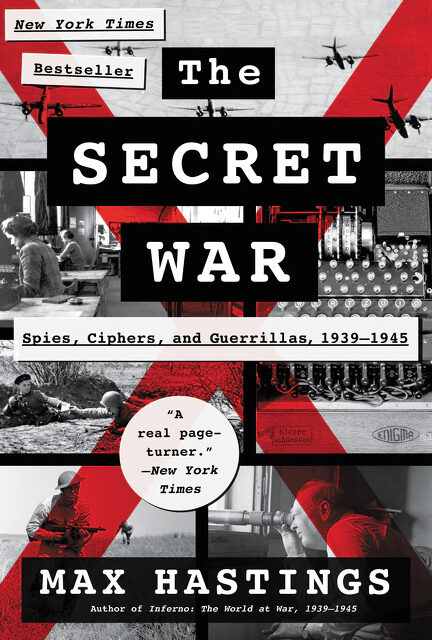
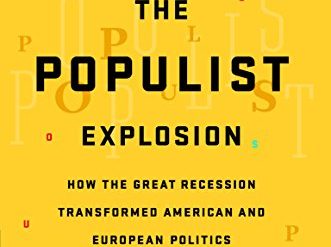
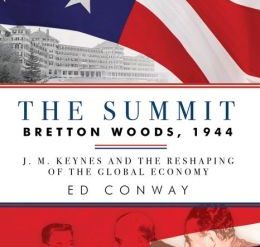

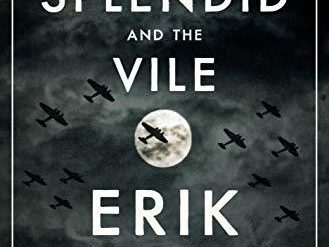





















Hi Mal, Leigh Plews, Melbourne, Australia. I am a retiree.
I am highly impressed by your article “7 common misconceptions about World War II.” It’s brilliant.
In Australia, over the last twenty years or so, uncritical jingoism regarding our contribution to both World Wars has increased enormously.
On a different topic, of which I know very little about, I have often been amazed at the seeming tenacity of the Vietnamese.
Cheers
Leigh
Thanks, Leigh. It’s always great to learn people actually read the stuff I write!